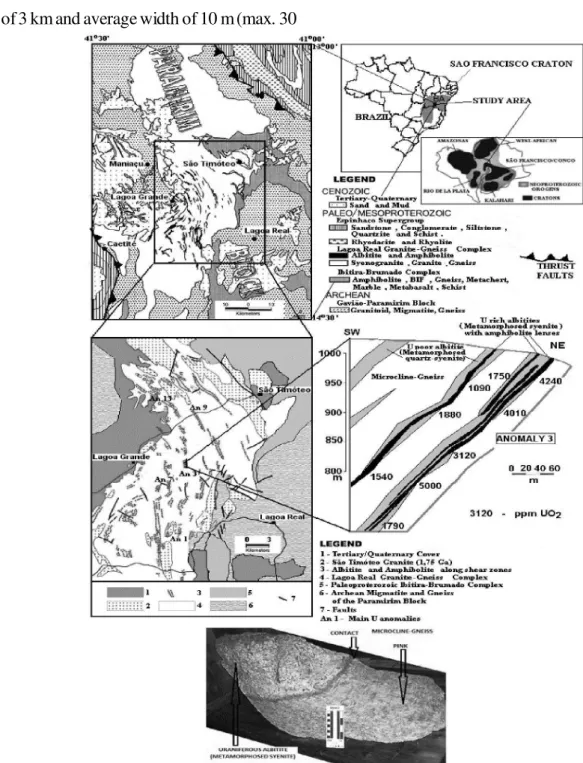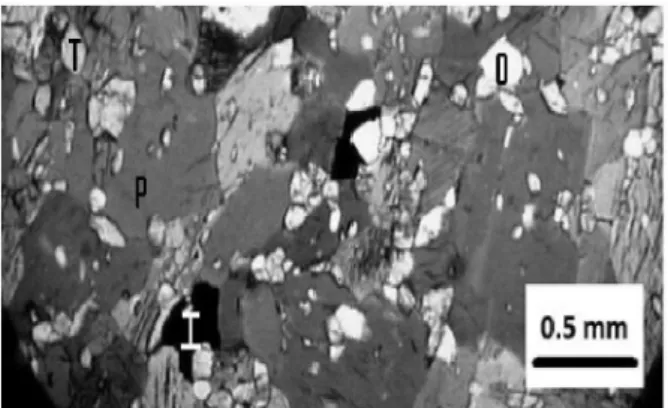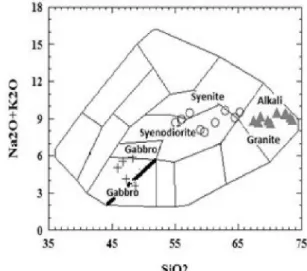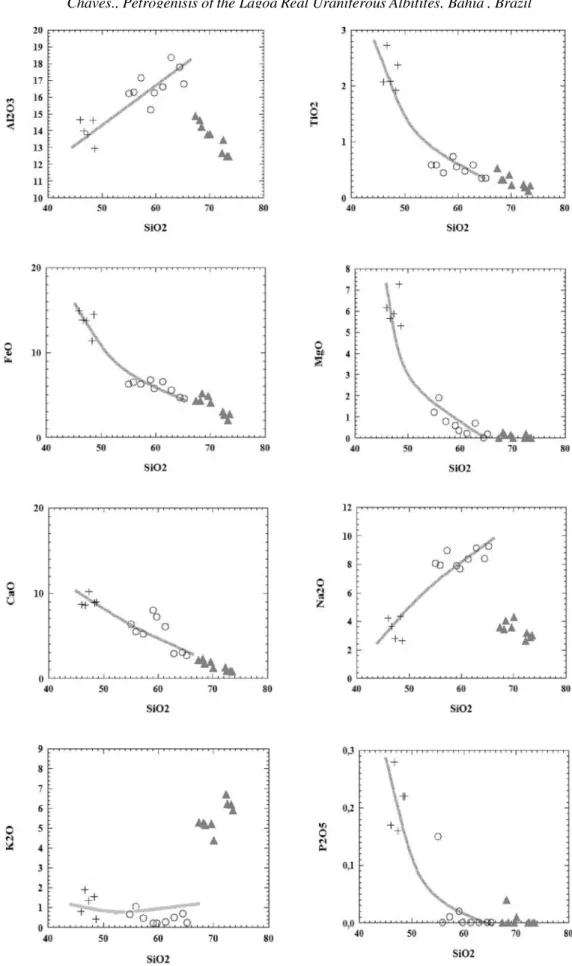Revista de Geologia, Vol. 24 (1), 2011
Revista de Geologia, Vol. 24, nº 1, 64 - 76, 2011 www.revistadegeologia.ufc.br
Petr ogenisis of the Ur anifer ous Albitites, Bahia, Br azil
Alexandr e de Oliveira Chaves
Recebido em 10 de junho de 2010 / Aceito em 28 de novembro de 2011
Abstr act
After Chaves et al. (2007), the crystallization and coeval deformation of the Lagoa Real uraniferous sodic syenite (uraniferous albitite protolith) took place along paleoproterozoic shear zones developed under regional late-orogenic tectonic conditions. The interpretation of new major elements, Zr and Th lithogeochemical data points to a petrogenetic connection between alkali-gabbro (local amphibolite protolith) and sodic syenite by fractional crystallization through transitional alkaline series. This magmatic differentiation occurred either before or during shear process, which in turn led to albitite and amphibolite formation. The regional microcline-gneiss, whose protolith is a syn-collisional potassic granite, represents the albitite host rock, and, apparently, it has no petrogenetic association to syenite (albitite protolith) in magmatic evolutive terms.
Keywords: lithogeochemistry, major elements, albitite, amphibolite, gneiss, Lagoa Real.
Resumo
Segundo Chaves et al. (2007), a cristalização e a deformação simultânea do sienito sódico uranífero de Lagoa Real (protólito do albitito uranífero local) ocorreu ao longo de zonas de cisalhamento paleoproterozóicas desenvolvidas em condições tardi-orogênicas por volta de 1,9 Ga. A interpretação de novos dados litogeoquímicos de elementos maiores, Zr e Th aponta para uma conexão genética entre um alcali-gabro (protólito do anfibolito local) e o sienito sódico por cristalização fracionada através da série alcalina transicional. Esta diferenciação magmática teria ocorrido antes ou durante o processo de cisalhamento, o qual, por sua vez, teria levado ao surgimento do anfibolito e albitito. A rocha encaixante do albitito, um microclina-gnaisse regional cujo protólito é um granito potássico sin-colisional, aparentemente não guarda relação genética com o mesmo em termos magmáticos evolutivos.
Palavras-Chave: litogeoquímica, elementos maiores, albitito, anfibolito, gnaisse, Lagoa Real.
Centro de Pesquisas Manoel Teixeira da Costa – Instituto de Geociências da Universidade Federal de Minas Gerais (CPMTC-IGC-UFMG) Av. Antônio Carlos, 6.627 - Pampulha – CEP 31270-901 Belo Horizonte - MG – Brazil,
1. Introduction
There are several geological mechanisms to form uranium deposits. On the subject of mechanisms associated to igneous rocks, Plant et al. (1999) point out that many uranium rich provinces are related to evolved felsic igneous rocks intruded in the crust, not only anorogenically, but also during the final moments of orogenesis. Furthermore, according to Bonin (1987), during the late orogenic processes, ductile shear fault zones control the site of emplacement of felsic magmatic provinces, some of them with associated uranium.
Uranium mineralization at Lagoa Real is found as finely disseminated (micro to millimetric) uraninite associated to mafic minerals (mainly garnet and pyroxene) belonging to discontinuous tabular bodies of albitites located along shear zones (Geisel Sobrinho, 1981; Ribeiro et al., 1984; Costa et al., 1985; Turpin et al., 1988; Lobato & Fyfe, 1990; Cordani et al., 1992). Geochronological studies related to Lagoa Real albitites have been done by Chaves et al. (2007, 2009) and LA-ICP-MS U-Pb dating of zircon and uraninite from albitites revealed protolith (uraniferous sodic syenites) crystallization and coeval deformation around 1.9 Ga along shear zones, which were active during the final moments of the Orosirian Orogeny.
Disseminated uraninite found inside garnet and pyroxene cryst allized during 1.9 Ga metamorphism from U released by uraniferous titanite of the syenite. Based on lithogeochemical data by using major and some trace elements, this article aims to show that syenite resulted of magmatic differentiation from alkali-gabbro either before or during shear process, which in turn led to local albitite and amphibolite formation, respectively. Such amphibolite often occurs along tabular bodies of albitites with the same structural trends and it was also affected by shear zones.
2. Geological Setting and Petr ography
The Lagoa Real region is located in the central part of São Francisco Craton (Fig. 1). The basement of this region is formed of Archean/ Paleoproterozoic granulitic, migmatitic, and gneissic rocks, which belong to the Paramirim and Gavião
blo cks (Inda & Barbosa, 1996). The Ibitira-Brumado volcanosedimentary unit is found in the area and comprises banded iron formations, gneisses, metacherts, marbles, and schists. Mascarenhas (1973) interpreted this unit as a Lower Paleoproterozoic greenstone belt.
Another important geological unit in the region is the Espinhaço Supergroup, comprising sandstones, conglomerates, siltstones, shales, quartzites and schists overlying a sequence of 1.7 Ga rhyolites and rhyodacites. This supergroup is related to a basin developed during Upper Paleoproterozoic rifting event. Tertiary covers and Quaternary alluvial sediments complete the geological scenario of this region.
According to Almeida (1977) and Cordani & Brito Neves (1982), the geological and tectonic context of the Lagoa Real region is part of the evolution of the São Francisco Craton and of successive geological cycles: Jequié (Archean - with orogenic event around 2.7 Ga), Transamazonian (Paleoproterozoic – with Orosirian orogenic event between 2.05 and 1.8 Ga), and Brasiliano (transition Neoproterozoic/Phanerozoic - with orogenic event between 650 and 490 Ma). During the latter cycle, Archean gneissic basement o vert hrusted metasedimentary rocks of the Espinhaço Supergroup and therefore N-S regional thrust faults are found in the Paramirim Block (Caby & Arthaud, 1987).
The Paleoproterozoic Lagoa Real Granitic-Gneissic Complex covers an area larger than 2,000 km2 of the Paramirim Block and includes granitoid
bodies, microcline-gneisses, albitites, and amphibolites. Abrupt contacts are found between uraniferous albitites bodies and their host rock, a microcline-gneiss (photography in the Fig. 1). As already mentioned, uranium mineralization at Lagoa Real is found as finely disseminated (micro to millimetric) uraninite associated to discontinuous tabular bodies of albitites located along shear zones. According to Costa et al. (1985), most bodies trend N40E to N30W and dip 30o to 90o to
Revista de Geologia, Vol. 24 (1), 2011
length of 3 km and average width of 10 m (max. 30 m).
Fig. 1 - Geological setting of the Lagoa Real uraniferous albitites, Bahia (BA-Brazil). Modified from Pascholathi et al. (2003) and Costa et al. (1985). Cross-section presents UO2 contents in ppm for some mineralized levels of the anomaly 3, which represents one of 34 mineralized albitite with high uranium content of the Lagoa Real Uraniferous Province. An abrupt contact between uraniferous albitites bodies and microcline-gneiss from Cachoeira Mine (anomaly 13) pit can be seen in photography. In addition to surrounding microcline-gneisses, samples of amphibolites and mineralized albitites from anomalies 1, 3, 7, 9, and 13 (An1, An3, An7, An9, and An13) have been investigated in this work.
Mineralization extends up to 850 m below the surface as shown by drill cores. Bodies contain one or more mineralized levels, which may be interrupted in places. Cross-section in Figure 1
Uraniferous Province.In such cross-section, amphibolites become visible along tabular bodies of albitites with the same structural trends and were also affected by shear zones.
Representative chemical analyses obtained by electron microprobe (Chaves et al., 2007) show that microcline-gneisses from Lagoa Real Complex are essentially formed by microcline and quartz. Some oligoclase, hastingsite, biotite, aegirine-augite, magnetite, titanite, allanite (Ce), fluorapatite, and zircon are also found.
Amphibolites from Lagoa Real Complex have granoblastic texture and are mineralogically represented by pargasite, oligoclase, abundant titanite, ilmenite, taramite (Na-amphibole), allanite-(Ce), zircon, fluorapatite, and calcite (Fig. 2).
Fig. 2 - Pargasite (P), oligoclase (O), abundant titanite (T) and some ilmenite (I) are some of minerals found in amphibolites, which have a granoblastic texture.
In albitites, mineralogical associations from magmatic and metamorphic episodes (Fig. 3) have been exposed by Chaves et al. (2007). Undeformed albitites (or syenites) keep igneous textures and essentially show albite and iron-rich augite. Some microcline, calcite, magnetite, U-rich titanite, allanite-(Ce), fluorapatite, zircon, fluorite, and apophyllite also appear. Additionally, Chaves et al. (2010) endorse the magmatic episode of the uraniferous albitites by melt inclusions found in some augite crystals. Melt inclusions, analysed by LA-ICP-MS, are richer in Na, Al and Ti than augite itself and there are some radiogenic 206Pb in the augite structure,
which reveals the previous presence of U in the syenite magma.
Metamorphosed albitites are formed by oligoclase, andradite, aegirine-augite, hastingsite, microcline, calcite, titanite, allanite-(Ce), fluorapatite, zircon, fluorite, epidote, biotite, uraninite, and hematite. Differently from Chaves et al. (2007), Maruéjol (1989) and Lobato & Fyfe (1990) assigned the genesis of the uranium-bearing albitites to metamorphism and progressive deformation of the 1.75 Ga anorogenic alkaline São Timóteo Granite along shear zones, where metasomatic processes took place under the influence of uranium and sodium-rich hydrothermal fluids from external sources.
3. Methodology
In order to understand the lithogeochemical evolution of the rocks from Lagoa Real Uraniferous Province, field work for geological survey and sample collecting from Cachoeira Mine pit (anomaly 13) and drill-core rocks from anomalies 1, 3, 7, and 9 of the Lagoa Real Uraniferous Province (Fig. 1) were undertaken. After that, twenty three representative samples (five amphibolites, nine uraniferous albitites, and nine microcline-gneisses) were comminuted for lithogeochemistry studies by using a ring mill. Total abundances of the major oxides and some trace elements were reported on a 2g sample analyzed at SGS Laboratories by Inductively Coupled Plasma Optical Emission Spectroscopy (major oxides) and Inductively Couple Plasma Mass Spectrometry (trace elements Zr and Th; U was not analyzed because its mobile behavior during hydrothermal events which affected albitites -Chaves et al., 2009) following a lithium metaborate/ tetraborate fusion and dilute nitric digestion.
Revista de Geologia, Vol. 24 (1), 2011
elements. The precision of analysis is usually in the 1-2% RSD (relative standard deviation) range. Loss
on ignition (LOI) took place by weight difference after ignition at 1000°C.
Fig. 3 - Anisotropy of metamorphic foliation in metamorphosed syenites (Chaves et al., 2007). Number 1 pictures show the magmatic episode found in region 1 of the scheme in the right side of the figure. They include antiperthites with microcline exsolved from albite. Number 2 pictures show the initial steps of the metamorphic recrystallization and would be from region 2 of the scheme. The recrystallization of a large albite crystal, associated with the recrystallization of iron-rich augite can be noted. Number 3 pictures show the final steps of the metamorphic recrystallization, in which the well developed granoblastic texture can be observed and would be from region 3 of the scheme (largest deformation). Metamorphic hastingsite appears in region 3 (Ab – Magmatic albite, Px – Magmatic augite, Mc – Magmatic microcline, AbR –Albite recrystallized during metamorphism, PxR – Augite recrystallized during metamorphism, Hb – hastingsite, a hornblende).
4. Results
Chemical analyses results of major oxides (weight %) and trace elements (ppm) are presented in Table 1, where are also shown CIPW normative minerals, calculated from Minpet software (Richard, 1996). Although analysed rocks are certainly of metamorphic category, CIPW data appear in Table 1 because following treatment allows to consider their igneous protoliths.
5. Treatment and discussion of results
In such diagrams, fan patterns indicate element mobilization and linear trends no element mobilization during metamorphism. Linear trends in figure 4 show that both Na and K were not representatively mobilized during metamorphism which affected albitites and microcline-gneiss.
Whereas there is no important mobilization of alkalis, lithogeochemical data from metamorphic
rocks can be treated as their igneous protoliths. In TAS diagram (Cox et al., 1979 – Fig. 5), albitite protolith range from syenite to syenodiorite and microcline-gneiss protolith is an alkali-granite. Additionally, amphibolite protolith can be understood as alkali-gabbro after TAS diagram, because samples are above dark line which separates alkaline and subalkaline rocks in the gabbro field.
Fig. 4 - Pearce diagrams (Pearce, 1968) for albitites (circles) and microcline-gneiss (triangle), where there are linear trends for Na and K elements (no representative alkalis mobilization during metamorphism).
Harker diagrams with silica versus major oxides (Fig. 6) and silica versus trace elements (Fig. 7) show petrogenetic relation between alkali-gabbro and syenitic rocks. In other words, reasonable trends linking them point to the fact that alkali-gabbroic basic magma probably differentiated by fractional crystallization to syenitic intermediate magma either before or during metamorphism along shear zones. Figures 6 and 7 show that silica increasing is accompanied by decreasing of Ti, Fe, Mg, Ca, P, but by increasing of Al, Na (hence albite, not K-feldspar, is formed in sodic syenite, the albitite protolith), Zr, and Th (immobile\incompatible HFS elements) during fractional crystallization from basic (alkali-gabbro) to intermediate (syenite) magma.
The petrogenetic relation by magmatic differentiation between alkali-gabbro and syenite can be better understood from alkali-silica diagram
Revista de Geologia, Vol. 24 (1), 2011
(Saggerson & Williams, 1964), where both rocks belong to the same transitional alkaline series (figure 8a), also named transalkaline series by Middlemost (1991).
Such magmatic series, characterized by absence of modal nepheline and presence of normative nepheline (see CIPW norm, samples amp# and some alb# - Tab.1), is located between alkaline and subalkaline series. Amphibolite protolith is a silica-saturated alkali-gabbro with normative nepheline. Albitite protolith is a syenite without modal quartz, but with normative quartz in some samples (alb11, alb23, and alb30). Quartz-syenites (non-uraniferous quartz-albitite pro tolith) lithostructurallyrelated to uraniferous albitites (see cross-section of the Fig. 1) have been described by Chaves et al. (2007, 2009) and certainly represent silica supersaturated next magmatic evolutive step from syenites in the transitional series. It is important to highlight that the sum Na2O+2 is higher than K2O contents for alkali-gabbro (amphibolite protolith) and syenite (albitite protolith) and, after Le Maitre (2002), they would be sodic rocks.
However, an alkali-calcic nature can be verified for alkali-gabbro (amphibolite protolith – cross) and syenite (albitite protolith – circle), after Peacock diagram (Peacock, 1931) of the figure 8b. Although the absence of normative corindon and acmite in syenite and granite allows to classify them as metaluminous rocks in terms of alumina saturation, Harker diagrams with silica versus Al, Na, K, Zr, and Th (figures 6 and 7) reveal that there is no petrogenetic relation between albitites (metamorphosed sodic syenites) and microcline-gneiss (metamorphosed potassic granites), as suggested by Chaves et al. (2009), because evolutive tendency lines are not found linking them. As shown by abrupt geological contacts in figure 1, syenitic magma probably intruded in previously crystallized potassic granite. R1 versus R2 multi-cationic diagram (Batchelor and Bowden,
1985) shown in figure 9 is a useful tool to test such probability.
After Batchelor and Bowden’s diagram, the geotectonic settings during granitic and syenitic intrusions were syn-collisional and apparently late-orogenic, respectively. In agreement with these settings, zircon U-Pb ages by LA-ICP-MS (Chaves et al., 2007, 2009) at 2009 +/- 78 Ma for microcline-gneiss (older potassic granite) would represent syn-collisional episode of the Orosirian Orogeny, and at 1904 +/- 44 Ma for uraniferous albitites (younger syenite) would represent late-orogenic shearing.
6. Conclusions
After treatment of the lithogeochemical data it is essential to highlight that, despite metamorphism, original magmatic chemistry can be recognized in all studied samples. Such observation implies in isochemical processes acting during metamorphism, which created Lagoa Real albitites, and processes like these are quite different from previous metasomatic petrogenetic models.
Lithogeochemical data point to a petrogenetic association between alkali-gabbro (amphibolite protolith) and sodic syenite (albitite protolith) by fractional crystallization through transitional alkaline series developed in a paleoproterozoic late-orogenic tectonic scenario. This magmatic differentiation occurred either before or during shear process, which in turn led to albitite and amphibolite formation. The regional microcline-gneiss, whose protolith is a syn-collisional potassic granite, represents the albitite host rock and, apparently, it has no petrogenetic association to late-orogenic sodic syenite (albitite protolith) in magmatic evolutive terms.
Revista de Geologia, Vol. 24 (1), 2011
Fig. 7 - Binary (Harker) diagrams with silica versus trace elements Zr and Th. Cross = amphibolite (protolith = alkali-gabbro), circle = uraniferous albitites (protolith = syenitic rocks), triangle = microcline-gneiss (protolith = alkali-granite).
Fig. 8 - A: Alkali-silica diagram (Saggerson & Williams, 1964), where alkali-gabbro (cross; amphibolite protolith) and syenite (circle; albitite protolith) belong to the same transitional alkaline series. B: Peacock diagram (Peacock, 1931) showing an alkali-calcic nature for alkali-gabbro (amphibolite protolith – cross) and syenite (albitite protolith – circle), in which black elipse represents the intersection between SiO
2 versus
CaO (dashed line with additional little black point in each sample) and SiO
2 versus alkalis
(continuous line) trends precisely in the alkali-calcic field.
Fig. 9 - R1 [4Si-11(Na+K)-2(Fe+Ti)] versus R2 [6Ca+2Mg+Al] milicationic diagram (Batchelor and Bowden, 1985) for geotectonic setting discrimination of granitoid rocks, after which syenites (albitite protolith; circles) belong to late-orogenic setting and potassic granites (microcline-gneiss protolith; triangles) belong to syn-collisional setting. Some circles were omitted because they plot outside the fields of the diagram.
progressively into more markedly alkaline within-plate suites, it is suggested that 1.75 Ga anorogenic alkaline São Timóteo Granite represents the closing within-plate stage of the aforementioned tectonic scenario.
Acknowledgements
Author thanks to CNPq, to Evando Carele de Matos (INB) on field support, and to friends from CDTN for unrestricted colaboration during this work.
Refer en ces
Almeida, F.F., 1977, O Cráton do São Francisco. Revista Brasileira de Geociências, 7: 349-364.
Batch elor, R. A., Bowden , P., 1985, Petrogenetic in ter pr etation of gr an itoid r ock ser ies usin g multicationic parameters. Chemical Geology, 48:43-65.
Bonin, B., 1987, From orogenic to anorogenic magmatism: a petrological model for the transition calc-alkaline – alkaline complexes. Revista Brasileira de Geociências, 17(4): 366-371.
Bonin, B., 2004, Do coeval mafic and felsic magmas in post-collisional to within-plate regimes necessarily imply two contrasting, mantle and crustal, sources ? A review. Lithos, 78: 1-24.
Caby, R., Arthaud M.H., 1987, Petrostructural evolution of the Lagoa Real metaplutonic complex (Bahia, Brazil).
Revista Brasileira de Geociências, 17: 636-636.
Chaves, A.O., Tubrett, M., Rios, F.J., Oliveira, L.A.R., Alves, J.V., Fuzikawa, K., Neves, J.M.C., Matos, E.C., Chaves, A.M.D.V., Prates, S.P., 2007, U-Pb ages related to uranium mineralization of Lagoa Real, Bahia - Brazil: tectonic implications. Revista de Geologia, 20(2): 141-156.
Chaves, A.O., Tubrett, M., Avelar, S.C.P., Rios, F.J., Sgarbi, G. N. C., Neves, J.M.C, Alves, J.V., Fuzikawa, K., Matos, E.C., Prates, S.P., 2009, Electron microprobe chemical U-Th-Pb and LA-ICP-MS U-Pb dating of multiple hydrothermal and metamorphic events recorded in minerals of the Lagoa Real uraniferous albitites (Brazil). Pesquisas em Geociências, 36:181-201.
Chaves, A.O., Rios, F. J., Alves, J.V., Chaves, A.M.D.V.,
Fuzikawa, K., Neves, J.M.C., 2010, Physical and chemical properties of fluid and melt inclusions of the Lagoa Real uraniferous albitites (Brazil). Revista de Geologia, 23(1): 90-100.
Cordani, U.G., Brito Neves, B.B., 1982, The geologic evolution of South America during the Archaean and Early Proterozoic. Revista Brasileira de Geociências, 12: 78-88.
Cordani, U.G., Iyer, S.S., Taylor, K., Kawashita, K., Sato, K., McReath, I., 1992, Pb-Pb, Rb-Sr, and K-Ar systematic of the Lagoa Real uranium province (south-central Bahia, Brazil) and the Espinhaço Cycle (ca. 1.5-1.0 Ga). Journal of South American Earth Sciences, 5: 33-46.
Costa, P.H.O., Andrade A.R..F, Lopes G.A., Souza S.L., 1985, Projeto Lagoa Real: Mapeamento Geológico, 1:25.000. CBPM, Salvador, v. 1.
Cox, K.G., Bell, J.D., Pankhurst, R.J., 1979, The interpretation of igneous rocks. London, Allen & Unwin, 450p.
Geisel, Sobrinho E., 1981, Apresentação de uma hipótese genética para o Distrito Uranífero de Lagoa Real. Nota Técnica EBHO.PM, No. 3, Nuclebrás, 35p.
Inda, H.V.A. & Barbosa, J.S.F., 1996, Texto explicativo para o mapa geológico do Estado da Bahia (1:1.000.000). In: J.S.L. Barbosa & J.M.S. Dominguez. Geologia da Bahia - Secretaria da Indústria, Comércio e Mineração, Superintendência de Geologia e Recursos Minerais, Salvador, 400p.
Revista de Geologia, Vol. 24 (1), 2011
Lobato, L.M. & Fyfe, W.S., 1990, Metamorphism, metasomatism, and mineralization at Lagoa Real, Bahia, Brazil. Economic Geology, 85: 968-989.
Mar uéjol, P., 1989, Métasomatose alcalin e et minéralisations uranifères: les albitites du gisement de Lagoa Real (Bahia, Brésil) et exemples complémentaires de Xihuashan (SE Chine), Zheltorechensk (Ukraine) et Chhuling Khola (Népal central). These Docteur, Centre de Recherches sur la Géologie de l’Uranium, Nancy, France, 428p.
Mascarenhas, J.F., 1973, A geologia do centro-leste do Estado da Bahia. 27o Congresso Brasileiro de Geologia, Aracaju, 2: 35-66.
Middlemost, E.A.K., 1991, Towards a comprehensive classification of igneous rocks and magmas. Earth Science Reviews, 31:73-87.
Pascolathi, E.M., Silva, C.L., Costa, S.S., Osako, L.S., Amaral, G., Rodriguez, I.P., 2003, Novas ocorrências de urânio na região de Lagoa Real, a partir da superposição de dados geofísicos, geológicos e de sensoriamento remoto. Revista Brasileira de Geociências, 33(2-suplemento): 91-98.
Peacock, M.A., 1931, Classification of igneous rock series. Journal of Geology: 39:54-67.
Pearce, T.H., 1968, A contribution to the theory of variation diagr ams. Con tr ibution s to Miner alogy an d Petrolology, 19:142-157.
Plant, J.A., Simpson, P.R., Smith, B., Windley, B., 1999, Uranium ore deposits – products of the radioactive Earth. In: Burns, P.C. & Finch, R. (Eds.) - Uranium: Mineralogy, Geochemistry and the Environment. Reviews in Mineralogy, Mineralogical Society of America, Vol. 33, p. 255-307.
Ribeiro, C.I., Carvalho Filho, C.A., Hashizume, S., 1984, As jazidas de urânio de Lagoa Real. Anais do 33o Congresso Brasileiro de Geologia, 1463-1474.
Richard, L.R., 1996, Minpet version 2.02 - Mineralogical and petrological data processing system for Windows. Quebec – Canada.
Saggerson, E.P. & Williams, L.A.J., 1964, Ngurumanite from southern Kenya and its bearing on the origin of rocks in the northern Tanganyika alkaline district. Journal of Petrology, 5:40-81.





![Fig. 9 - R1 [4Si-11(Na+K)-2(Fe+Ti)] versus R2 [6Ca+2Mg+Al] milicationic diagram (Batchelor and Bowden, 1985) for geotectonic setting discrimination of granitoid rocks, after which syenites (albitite protolith; circles) belong to late-orogenic s](https://thumb-eu.123doks.com/thumbv2/123dok_br/15294087.545946/9.892.85.382.420.842/milicationic-batchelor-geotectonic-discrimination-granitoid-syenites-albitite-protolith.webp)